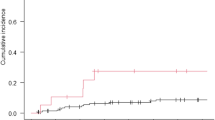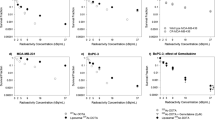Abstract
Purpose
Radioimmunotherapy (RIT) delivered through the cerebrospinal fluid (CSF) has been shown to be a safe and promising treatment for leptomeningeal metastases. Pharmacokinetic models for intraOmmaya antiGD2 monoclonal antibody 131I-3F8 have been proposed to improve therapeutic effect while minimizing radiation toxicity. In this study, we now apply pharmacokinetic modeling to intraOmmaya 131I-omburtamab (8H9), an antiB7-H3 antibody which has shown promise in RIT of leptomeningeal metastases.
Methods
Serial CSF samples were collected and radioassayed from 61 patients undergoing a total of 177 intraOmmaya administrations of 131I-omburtamab for leptomeningeal malignancy. A two-compartment pharmacokinetic model with 12 differential equations was constructed and fitted to the radioactivity measurements of CSF samples collected from patients. The model was used to improve anti-tumor dose while reducing off-target toxicity. Mathematical endpoints were (a) the area under the concentration curve (AUC) of the tumor-bound antibody, AUC [CIAR(t)], (b) the AUC of the unbound “harmful” antibody, AUC [CIA(t)], and (c) the therapeutic index, AUC [CIAR(t)] ÷ AUC [CIA(t)].
Results
The model fit CSF radioactivity data well (mean R = 96.4%). The median immunoreactivity of 131I-omburtamab matched literature values at 69.1%. Off-target toxicity (AUC [CIA(t)]) was predicted to increase more quickly than AUC [CIAR(t)] as a function of 131I-omburtamab dose, but the balance of therapeutic index and AUC [CIAR(t)] remained favorable over a broad range of administered doses (0.48–1.40 mg or 881–2592 MBq). While antitumor dose and therapeutic index increased with antigen density, the optimal administered dose did not. Dose fractionization into two separate injections increased therapeutic index by 38%, and splitting into 5 injections by 82%. Increasing antibody immunoreactivity to 100% only increased therapeutic index by 17.5%.
Conclusion
The 2-compartmental pharmacokinetic model when applied to intraOmmaya 131I-omburtamab yielded both intuitive and nonintuitive therapeutic predictions. The potential advantage of further dose fractionization warrants clinical validation.
Clinical trial registration
ClinicalTrials.gov, NCT00089245.








Similar content being viewed by others
Availability of data and material
Data reported in the manuscript will be shared under the terms of a Data Use Agreement and may only be used for approved proposals. Requests may be made to: crdatashare@mskcc.org.
References
Larson SM, Carrasquillo JA, Cheung NK, Press OW. Radioimmunotherapy of human tumours. Nat Rev Cancer. 2015;15:347–60. https://doi.org/10.1038/nrc3925.
Cheung NK, Landmeier B, Neely J, Nelson AD, Abramowsky C, Ellery S, et al. Complete tumor ablation with iodine 131-radiolabeled disialoganglioside GD2-specific monoclonal antibody against human neuroblastoma xenografted in nude mice. J Natl Cancer Inst. 1986;77:739–45.
Modak S, Kramer K, Gultekin SH, Guo HF, Cheung NK. Monoclonal antibody 8H9 targets a novel cell surface antigen expressed by a wide spectrum of human solid tumors. Cancer Res. 2001;61:4048–54.
Modak S, Guo HF, Humm JL, Smith-Jones PM, Larson SM, Cheung NK. Radioimmunotargeting of human rhabdomyosarcoma using monoclonal antibody 8H9. Cancer Biother Radiopharm. 2005;20:534–46.
Souweidane MM, Kramer K, Pandit-Taskar N, Zhou Z, Haque S, Zanzonico P, et al. Convection-enhanced delivery for diffuse intrinsic pontine glioma: a single-centre, dose-escalation, phase 1 trial. Lancet Oncol. 2018;19:1040–50. https://doi.org/10.1016/S1470-2045(18)30322-X.
Kramer K, Humm JL, Souweidane MM, Zanzonico PB, Dunkel IJ, Gerald WL, et al. Phase I study of targeted radioimmunotherapy for leptomeningeal cancers using intra-Ommaya 131-I-3F8. J Clin Oncol. 2007;25:5465–70.
Kramer K, Pandit-Taskar N, Humm JL, Zanzonico PB, Haque S, Dunkel IJ, et al. A phase II study of radioimmunotherapy with intraventricular 131 I-3F8 for medulloblastoma. Pediatr Blood Cancer. 2017. https://doi.org/10.1002/pbc.26754.
Kramer K, Kushner BH, Modak S, Pandit-Taskar N, Smith-Jones P, Zanzonico P, et al. Compartmental intrathecal radioimmunotherapy: results for treatment for metastatic CNS neuroblastoma. J Neuro-Oncol. 2010;97:409–18. https://doi.org/10.1007/s11060-009-0038-7.
Kramer K, Pandit-Taskar N, Zanzonico P, Wolden SL, Humm JL, DeSelm C, et al. Low incidence of radionecrosis in children treated with conventional radiation therapy and intrathecal radioimmunotherapy. J Neuro-Oncol. 2015;123:245–9. https://doi.org/10.1007/s11060-015-1788-z.
Pandit-Taskar N, Zanzonico PB, Kramer K, Grkovski M, Fung EK, Shi W, et al. Biodistribution and dosimetry of intraventricularly administered (124)I-omburtamab in patients with metastatic leptomeningeal tumors. J Nucl Med. 2019;60:1794–801. https://doi.org/10.2967/jnumed.118.219576.
He P, Kramer K, Smith-Jones P, Zanzonico P, Humm J, Larson SM, et al. Two-compartment model of radioimmunotherapy delivered through cerebrospinal fluid. Eur J Nucl Med Mol Imaging. 2011;38:334–42. https://doi.org/10.1007/s00259-010-1633-8.
Lv Y, Cheung NK, Fu BM. A pharmacokinetic model for radioimmunotherapy delivered through cerebrospinal fluid for the treatment of leptomeningeal metastases. J Nucl Med. 2009;50:1324–31.
Ahmed M, Cheng M, Zhao Q, Goldgur Y, Cheal SM, Guo HF, et al. Humanized affinity-matured monoclonal antibody 8H9 has potent antitumor activity and binds to FG loop of tumor antigen B7-H3. J Biol Chem. 2015;290:30018–29. https://doi.org/10.1074/jbc.
Picarda E, Ohaegbulam KC, Zang X. Molecular pathways: targeting B7-H3 (CD276) for human cancer immunotherapy. Clin Cancer Res. 2016;22:3425–31. https://doi.org/10.1158/1078-0432.CCR-15-2428.
Yerrabelli RS. Pharmacokinetic modeling and optimization of omburtamab (8H9) delivered through the CSF. Zenodo, v1.1.0, (2020). https://doi.org/10.5281/zenodo.4072446.
Brassow F, Baumann K. Volume of brain ventricles in man determined by computer tomography. Neuroradiology. 1978;16:187–9.
Costanzo LS. Physiology. Sixth edition. Ed. Philadelphia: Elsevier; 2018.
Blix HS, Viktil KK, Moger TA, Reikvam A. Drugs with narrow therapeutic index as indicators in the risk management of hospitalised patients. Pharm Pract (Granada). 2010;8:50–5. https://doi.org/10.4321/s1886-36552010000100006.
May C, Kaye JA, Atack JR, Schapiro MB, Friedland RP, Rapoport SI. Cerebrospinal fluid production is reduced in healthy aging. Neurology. 1990;40:500–3. https://doi.org/10.1212/wnl.40.3_part_1.500.
Silverberg GD, Heit G, Huhn S, Jaffe RA, Chang SD, Bronte-Stewart H, et al. The cerebrospinal fluid production rate is reduced in dementia of the Alzheimer’s type. Neurology. 2001;57:1763–6.
Carrion E, Hertzog JH, Medlock MD, Hauser GJ, Dalton HJ. Use of acetazolamide to decrease cerebrospinal fluid production in chronically ventilated patients with ventriculopleural shunts. Arch Dis Child. 2001;84:68–71. https://doi.org/10.1136/adc.84.1.68.
Thiry A, Dogne JM, Supuran CT, Masereel B. Carbonic anhydrase inhibitors as anticonvulsant agents. Curr Top Med Chem. 2007;7:855–64. https://doi.org/10.2174/156802607780636726.
Leaf DE, Goldfarb DS. Mechanisms of action of acetazolamide in the prophylaxis and treatment of acute mountain sickness. J Appl Physiol. 2007;102:1313–22. https://doi.org/10.1152/japplphysiol.01572.2005.
Jafarzadeh F, Field ML, Harrington DK, Kuduvalli M, Oo A, Kendall J, et al. Novel application of acetazolamide to reduce cerebrospinal fluid production in patients undergoing thoracoabdominal aortic surgery. Interact Cardiovasc Thorac Surg. 2014;18:21–6. https://doi.org/10.1093/icvts/ivt384.
Kaye JA, DeCarli C, Luxenberg JS, Rapoport SI. The significance of age-related enlargement of the cerebral ventricles in healthy men and women measured by quantitative computed X-ray tomography. J Am Geriatr Soc. 1992;40:225–31. https://doi.org/10.1111/j.1532-5415.1992.tb02073.x.
Ott BR, Cohen RA, Gongvatana A, Okonkwo OC, Johanson CE, Stopa EG, et al. Brain ventricular volume and cerebrospinal fluid biomarkers of Alzheimer's disease. J Alzheimers Dis. 2010;20:647–57. https://doi.org/10.3233/JAD-2010-1406.
O'Donoghue JA, Sgouros G, Divgi CR, Humm JL. Single-dose versus fractionated radioimmunotherapy: model comparisons for uniform tumor dosimetry. J Nucl Med. 2000;41:538–47.
Acknowledgments
We thank Anita Tsen-hui Louie of Vanderbilt University and Ronald Blasberg of Memorial Sloan Kettering Cancer Center for their critical review and revisions of the manuscript.
Funding
This was supported in part by the NCI Cancer Center Support Grant P30 CA008748, Enid A. Haupt Endowed Chair (NKC), and the Robert Steel Foundation (NKC).
Author information
Authors and Affiliations
Corresponding author
Ethics declarations
Conflict of interest
NKC reports receiving commercial research grants from Y-mabs Therapeutics and Abpro-Labs Inc.; holding ownership interest/equity in Y-Mabs Therapeutics Inc., holding ownership interest/equity in Abpro-Labs, and owning stock options in Eureka Therapeutics. NKC is the inventor and owner of issued patents licensed by MSK to Ymabs Therapeutics, Biotec Pharmacon, and Abpro-labs. Naxitamab and omburtamab were licensed by MSK to Y-mabs Therapeutics. Both MSK and NKC have financial interest in Y-mabs. NKC is an advisory board member for Abpro-Labs and Eureka Therapeutics.
Ethical approval
Prior to enrolling patients, the human subjects research described in this article was approved by the Institutional Review Board of Memorial Sloan Kettering Cancer Center and listed on clinicaltrials.gov (NCT00089245). All patients taking part in the study or their legal guardian provided informed consent to participate in the clinical trial. This study was performed in line with the principles of the Declaration of Helsinki.
Code availability
Data and computational parameters used in MATLAB are supplied as supplement to this manuscript. The model and ready-to-run code to run it have been made available in reference [15].
Additional information
Publisher’s note
Springer Nature remains neutral with regard to jurisdictional claims in published maps and institutional affiliations.
This article is part of the Topical Collection on Oncology – Brain.
Electronic supplementary material
ESM 1
(DOCX 8.98 mb)
Rights and permissions
About this article
Cite this article
Yerrabelli, R.S., He, P., Fung, E.K. et al. IntraOmmaya compartmental radioimmunotherapy using 131I-omburtamab—pharmacokinetic modeling to optimize therapeutic index. Eur J Nucl Med Mol Imaging 48, 1166–1177 (2021). https://doi.org/10.1007/s00259-020-05050-z
Received:
Accepted:
Published:
Issue Date:
DOI: https://doi.org/10.1007/s00259-020-05050-z




